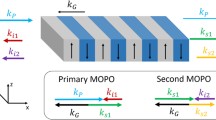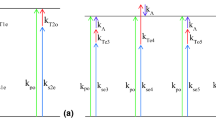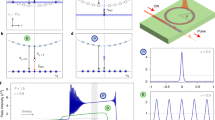Abstract
We examine theoretically under what conditions mirrorless optical parametric oscillation can be obtained in PPLN and PPLT. We take into account the damage threshold, idler absorption and domain width fluctuations, as well as competing nonlinear processes that may deplete the pump before oscillation occurs. We also solve numerically the coupled wave equations to take into account the buildup from quantum fluctuations to a detectable level. We found that there is a pulsewidth that minimizes the required pump energy to observe mirrorless oscillation. For a perfect 2-cm-long PPLN sample, a 700-ps, 1.064-µm pump with a 50-µm radius and a counter-propagating 4.5-µm idler, fifth-order quasi-phase-matched oscillation can be obtained with less than 70 µJ. For PPLT, the requirements are higher (200 µJ for a perfect 2.5-cm PPLT sample). Mirrorless oscillation in bulk PPLN and PPLT requires almost perfect domain structures. The average duty cycle must be very close to the ideal value of 50%. For fifth-order quasi-phase-matching in 2-cm-long PPLN, fluctuations with a standard deviation of up to ~300 nm are acceptable. For third-order quasi-phase-matching, the requirements are less: In PPLN standard deviations of up to 450 nm are acceptable and in PPLT this value is ~300 nm.












Similar content being viewed by others
References
V.Ya. Shur, Ferroelectrics 443, 71 (2013)
S.E. Harris, Appl. Phys. Lett. 9, 114 (1966)
C. Canalias, V. Pasiskevicius, Nat. Photonics 1, 459 (2007)
V.Ya. Shur, E.L. Rumyantsev, E.V. Nikolaeva, E.I. Shishkin, R.G. Batchko, G.D. Miller, M.M. Fejer, R.L. Byer, Ferroelectrics 236, 129 (2000)
A.C. Busacca, C.L. Sones, V. Apostopoulos, R.W. Eason, S. Mailis, Appl. Phys. Lett. 81, 4946 (2002)
S. Mailis, C. Riziotis, I.T. Wellington, P.G.R. Smith, C.B.E. Gawith, R.W. Eason, Opt. Lett. 28, 1433–1435 (2003)
C.L. Sones, C.E. Valdivia, J.G. Scott, S. Mailis, R.W. Eason, D.A. Scrymgeour, V. Gopalan, T. Jungk, E. Soergel, Appl. Phys. B 80, 341 (2005)
C. E. Valdivia, C. L. Sones, S. Mailis, R. W. Eason, Ultrashort-pulse light-assisted periodic poling of lithium niobate and lithium tantalate, in Conference on Lasers and Electro-Optics/Quantum Electronics and Laser Science Conference and Photonic Applications Systems Technologies, Technical Digest (CD), paper CMB2 (Optical Society of America, 2006)
J.U. Kang, Y.J. Ding, W.K. Burns, J.S. Melinger, Opt. Lett. 22, 862 (1997)
X. Gu, R.Y. Korotkov, Y.J. Ding, J.U. Kang, J.B. Khurgin, J. Opt. Soc. Am. B 15, 1561 (1998)
A.C. Busacca, S. Stivala, L. Curcio, A. Tomasino, G. Assanto, Opt. Express 22, 7544 (2014)
Y.J. Ding, J.B. Khurgin, IEEE J. Quantum Electron. 22, 1574 (1996)
D.H. Jundt, Opt. Lett. 22, 1553 (1997)
N. Barboza, R.S. Cudney, Appl. Phys. B 95, 453 (2009)
S.J. Brosnan, R.L. Byer, IEEE J. Quantum Electron. QE-15, 415 (1979)
M.J. Missey, V. Dominic, P.E. Powers, Opt. Lett. 24, 1227 (1999)
Y. Furukawa, A. Yokotani, T. Sasaki, H. Yoshida, K. Yoshida, F. Nitanda, M. Sato, J. Appl. Phys. 69, 3372 (1991)
R.C. Miller, Appl. Phys. Lett. 5, 17 (1964)
I. Shoji, T. Kondo, A. Kitamoto, M. Shirane, R. Ito, J. Opt. Soc. Am. B 14, 2268 (1997)
F. Kalkum, H.A. Eggert, T. Jungk, K. Buse, J. Appl. Phys. 102(1), 014104 (2007)
S. Helmfrid, G. Arvidsson, J. Opt. Soc. Am. B 8, 797 (1991)
M.M. Fejer, G.A. Magel, D.H. Jundt, R.L. Byer, IEEE J. Quantum Electron. 28, 2631 (1992)
C.R. Phillips, J.S. Pelc, M.M. Fejer, J. Opt. Soc. Am. B 30, 982 (2013)
M. Taya, M.C. Bashaw, M.M. Fejer, Opt. Lett. 21, 857 (1996)
D.D. Lowenthal, IEEE J. Quantum Electron. 34, 1356 (1998)
L. Lefort, K. Puech, G.W. Ross, Y.P. Svirko, D.C. Hanna, Appl. Phys. Lett. 73, 1610 (1998)
M.A. Watson, M.V. O’Connor, P.S. Lloyd, D.P. Shepherd, D.C. Hanna, C.B.E. Gawith, L. Ming, P.G.R. Smith, O. Balachninaite, Opt. Lett. 27, 2106 (2002)
G. Rustad, G. Arisholm, Ø. Farsund, Opt. Express 19, 2815 (2011)
H. Su, S. Ruan, Y. Guo, J. Opt. Soc. Am. B 23, 1626 (2006)
M. Leidinger, S. Fieberg, N. Waasem, F. Kühnemann, K. Buse, I. Breunig, Opt. Express 23, 21690 (2015)
S. Sanna, S. Neufeld, M. Rüsing, G. Berth, A. Zrenner, W.G. Schmidt, Phys. Rev. B. 91, 224302 (2015)
A.V. Okishev, J.D. Zuegel, Opt. Express 14, 12169 (2006)
M. Bache, R. Schiek (2012), arXiv:1211.1721
C. Montes, P. Aschieri, A. Picozzi, in SPIE Proceedings Series 8011 (2011)
G. Strömqvist, V. Pasiskevicius, C. Canalias, P. Aschieri, A. Picozzi, C. Montes, J. Opt. Soc. Am. B 29, 1194 (2012)
V. Pasiskevicius, C. Canalias, G. Strömqvist, F. Laurell, in SPIE Proceedings Series 6875 (2008)
J.S. Pelc, C.R. Phillips, D. Chang, C. Langrock, M.M. Fejer, Opt. Lett. 36, 864 (2011)
Acknowledgements
The authors would like to thank S. Stepanov for pointing out useful ideas for this work. C. E. Minor gratefully acknowledges pleasant conversations with Miguel Martínez† and funding from CONACyT.
Author information
Authors and Affiliations
Corresponding author
Appendices
Appendix 1: Derivation of the equations used in the numerical simulation
Here, we derive the set of Eq (12) that was used to obtain the numerical solutions given in the text. We start with the first of the set of Eq. (4),
Integrating both sides from \( x - \Delta x \) to \( x + \Delta x \) and using \( A = \sqrt {n/\omega } E \),
where \( \gamma = \frac{1}{c}\sqrt {\frac{{\omega_{p} \omega_{s} \omega_{i} }}{{n_{p} n_{s} n_{i} }}} d_{33} \). The left-hand side can be approximated by
For our convenience, we set \( \delta x = v_{s} \delta t \) (Courant–Friedrichs–Lewy condition). After rearranging terms, we get
Again for our convenience, we set \( \delta x = 2\Delta x \) and \( \delta t = 2\Delta t \), obtaining
We now evaluate the right-hand side. In general, \( g(x)\exp (i\Delta kx) \) will vary considerably from \( x - \Delta x \) to \( x + \Delta x \) as long as this interval is larger than a few domains. However, the pump and idler do not change appreciably over this interval, so \( A_{p} \) and \( A_{i}^{*} \) may be taken out of the integral; therefore,
where \( \varPhi \left( x \right) = \int\nolimits_{x - \Delta x}^{x + \Delta x} {g\left( {x'} \right)} \exp \left( {i\Delta kx'} \right)dx' \). Putting everything together, we finally obtain
which is the first of the set of Eq. (12).
Following the same procedure and making the approximation \( v_{s} \approx v_{i} \approx v_{p} \) (in order to use the same time and space steps \( \Delta t \) and \( \Delta x \)), we get the remaining equations,
Notice that \( \varPhi \) is only a function of \( x \) and not of \( t \), so it only has to be evaluated once for a given domain structure \( g(x) \) and momentum mismatch \( \Delta k \); this drastically decreases the time required to solve these equations numerically.
Appendix 2: Derivation of the Raman gain coefficient and modification of the set of coupled equations
Okishev and Zuegel [32] observed oscillation due to stimulated Raman scattering in a continuous-wave OPO that used MgO:PPLN as the nonlinear medium. The OPO was pumped by a 1.06-µm laser focused to a diameter of ~200 µm inside the 5-cm-long crystal. The cavity was resonant to the signal wavelength (~1.6 µm), and both mirrors had a reflectivity of 99.8% at the signal wavelength. From the data presented in their paper (0.5 W threshold, 200 mW signal output when pumped with 8 W) and assuming a linear dependence between the pump and signal power, we infer the internal and external signal power, shown in Fig. 13.
External and internal signal power versus pump power. The graph was inferred from data given in [32]
Oscillation of stimulated Raman scattering was observed at a pump power of 1.9 W, which corresponds to an internal signal power of 18.7 W. Several stokes shifts, ranging from 46 to 631 cm−1, were observed.
From these data, we may estimate the Raman gain coefficient \( \sigma_{\text{srs}} \). At threshold, the gain from stimulated Raman must equal its losses, so
where \( d \) is the crystal length, \( I_{p} \) and \( P_{p} \) are the pump intensity and pump power, respectively, \( w_{p} \) is the beam radius, and we have assumed that \( R_{1} = R_{2} = R \), which is essentially the same as the reflectivity for the signal wavelength, 99.8%. From this equation, we estimate that \( \sigma_{\text{srs}} \approx 6.7{\text{cm/GW}} \).
The equation set used in the numerical simulation was modified to take stimulated Raman scattering into account. Only a single Stokes line was taken into consideration; anti-Stokes and higher-order Stokes shifts were neglected. An additional equation for the amplitude \( A_{\text{srs}} \) of the stokes line was introduced, and an extra term for pump depletion due to the stokes line was added to the equation for the pump wave:
where \( \kappa_{\text{srs}} = \frac{{\sigma_{\text{srs}} \varepsilon_{0} c^{2} \pi }}{{\lambda_{p} }}\Delta x \).
Rights and permissions
About this article
Cite this article
Minor, C.E., Cudney, R.S. Mirrorless optical parametric oscillation in bulk PPLN and PPLT: a feasibility study. Appl. Phys. B 123, 38 (2017). https://doi.org/10.1007/s00340-016-6602-x
Received:
Accepted:
Published:
DOI: https://doi.org/10.1007/s00340-016-6602-x





